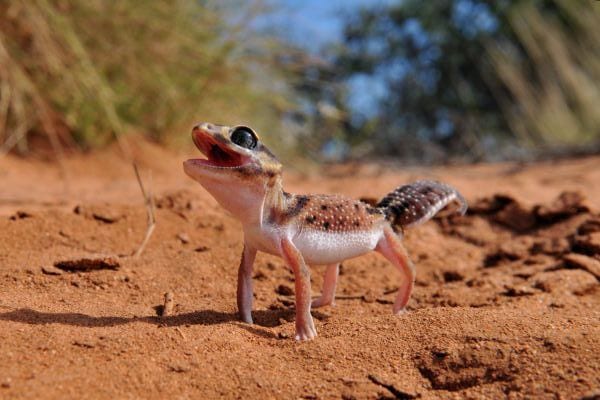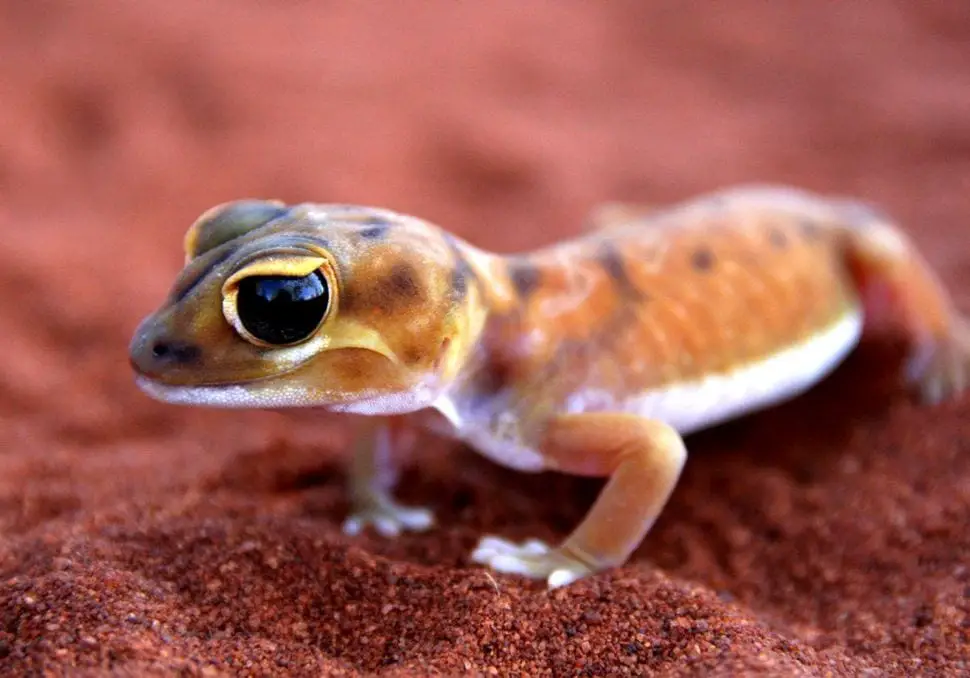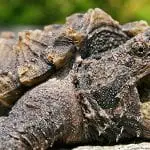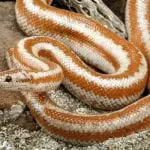Scientific Facts
| Common Name | Smooth knob-tailed gecko |
| Scientific Name | Nephrurus levis |
| Range | Western Australia |
| Habitat | Open woodlands, open deserts, sand-plains, dune fields, grasslands or in an arid or semi-arid places |
| Lifespan | 8 to 15 Years |
| Diet | Cockroaches, scorpions, centipedes, spiders, grasshoppers, beetles, caterpillars and smaller geckos |
| Size | 3 to 4½ inches |
| Color | Pinkish-gray or purplish-brown color |
Physical Description

Smooth knob-tailed gecko is an endemic species to Australia. This is characterized by its triangular head and medium-sized body. It has a large eye with vertical pupils that match its slit ears. Its long slender limbs allow it to move fast. It has a dorsal color of pinkish-gray or purplish-brown color with patterns of bars or lines that have dark and light pigmentation. It has a belly button that is color white. It has white or dark spots or tubercles all around its body until its tail.
Where it is Seen?
This species is distributed throughout the desert areas of Australia, throughout Adelaide and mainland Victoria where it is hot and humid.
Habitat
The smooth knob-tailed gecko thrives in different ranges of habitat, including open woodlands, open deserts, sand-plains, dune fields, grasslands, or in arid or semi-arid places. They are often seen underground where they burrow.
Behavior and temperament
This reptile is nocturnal that loves to dwell in their self-made shelter or other animals’ burrow. They would find their prey at night, especially after the rain, where almost insects are outside. Compared to other gecko species, the smooth knob-tailed gecko has the ability to withstand lower temperatures; that is why going out at night is an advantage for them.
During a sunny day, they spend their time laying on a rock basking, especially after eating because it is a way for them to digest their food easily. A way for them to show excitement and aggressiveness is through waving their tails. When they are threatened, they sway their bodies, wind their tails, bark loudly, and they attack their predator with an open mouth.
Diet
The smooth knob-tailed gecko is an insectivore where their prey consists of only insects such as cockroaches, scorpions, centipedes, spiders, grasshoppers, beetles, caterpillars, and smaller geckos.
Breeding and Reproduction
The mating season for the smooth knob-tailed gecko is around October and March, which are considered as the warm months. An indication that a female knob-tailed gecko is ready to breed if it shows receptive behaviors towards the males for them to mate. However, females who are not yet ready to breed would run away, or they will attack the male.
After mating, the eggs will be formed around 4-9 weeks and expect that these eggs will hatch after 8 weeks as long as the eggs are exposed to at least 28-29°C. The hatchlings will shed their skin within 24 hours after the eggs cracked before they push themselves upwards, using their tiny legs to see the world.
Size and Weight
These reptiles are measured from their snout until their tail’s length. They have an average size of 8-10 centimeters (3.1–4 in). If they dropped their tail, their size is decreased by 1 inch. The females tend to be larger than males.
Life Span
This is the type of gecko that has quite a short lifespan compared to other geckos. Like other animals taken into captivity, they tend to have a lifespan longer than they are in the wild. The oldest knob-tailed gecko recorded in captivity is about 15 years old, while research shows that its lifespan in the wild will only reach up to 8 years because of some destructive factors.
Shedding
Like other reptiles, knob-tailed gecko also shed their skin occasionally. Females tend to shed their skin more often, especially before they lay their eggs. For them to shed easily, the proper humidity level should be maintained.
If there is a problem with humidity, there is a possibility that they will shed in pieces and that there will be retained skin. This species will eat their skin after shedding to recycle nutrients found on the shredded skin.
Common Disease/Illnesses
Stuck shed
The improper humidity level is the common cause of stuck shed. If the environment is too dry and too wet, expect that your pet will have a hard time shedding. If this happens, don’t touch them and try removing the skin because you might hurt their delicate skin. Increase the humidity level by spraying their tank with water.
Regurgitation
This happens when the food given to them is large enough that their body lacks the right temperature to digest and thermoregulate it. To address this issue, make sure to give them just the right size of food and see to it that the temperature level is at the optimum level.
Metabolic bone disease
This is a common disease to reptiles, especially when they lack a certain nutrient. Since they only feed on insects, it is advisable to feed the insects with vegetables so that when the knob-tailed gecko will eat those insects, the nutrients in the insects will also be absorbed in the reptile’s body. There are also supplements found in the market that you can mix in their water or food so that the nutrients will be totally absorbed by their bodies.
Blister skin disease
It may be difficult to confirm if your pet has blister skin disease because of one of their skin colors. You may need to check their skin properly for any signs. The best way to see any blisters is to handle them and check their skin one by one. Blister disease shouldn’t be ignored because this causes pain and great irritations to your pet. In extreme cases, their skin will be wounded and will be prone to infection that can be fatal.
Preventing Illnesses
These common diseases and illnesses that may be experienced by a knob-tailed gecko are commonly due to poor husbandry and lack of nutrition. This reptile is a hardy reptile, as long as you attend to their needs for sure, it will stay long in captivity. You need to practice good hygiene by means of cleaning their tank at least twice a week. The food that you should give them should be enriched with nutrients that they can swallow easily. You should always be attentive to their needs by checking up on them from time to time.
Just by doing simple steps, you can be sure that your reptile pet will grow healthily, avoiding these health issues. When your pet grows and goes towards maturity, they can develop immunity against different kinds of illnesses as long as you expose them to an environment that is ideal.
Captive Breeding
knob-tailed gecko is commonly seen in captivity, but unlike other lizard species, this reptile does not like to be handled because they get threatened easily. It is commonly maintained in captivity because it will thrive in any condition as long as the humidity level is controlled. This species may have hardy characteristics, but you still need to provide its need for it to grow healthily.
How to Take Good Care Reptile as a Pet?
Housing
This species is best to be kept individually in at least 7-10 gallon aquarium. Your goal is to make housing that mimics a desert-like appearance. The cage should have wet areas where they can cool and refresh their bodies. Their housing should be equipped with accessories where they can do the activities that they wanted, such as burrowing and hiding.
Lighting and Temperature
These reptiles are nocturnal; that is why they do not need any light cycle exposure even for basking, but what they need is a warmer or a heater that works well with an aquarium. It is ideal for placing the warmer in just one side of the aquarium with at least 87 to 89 degrees Fahrenheit maintaining temperature.
Substrate and accessories
The only substrate that is ideal for their housing is fine-grain sand. There should be enough amount of sand about 4-5 inches where they can burrow and create small tunnels. There should be a basin of water on one side of the aquarium where they can drink and soak their bodies at times. Since these reptiles are secretive, make sure to add hide boxes for them to have a shelter to feel comfort and security at least one or two retreats.
Food and water
Knob-tailed geckos are fed with cockroaches, crickets, ants, spiders, caterpillars, beetles, scorpions, and other insects. These reptiles tend to have a fast metabolism that is why keepers give them food at least 4-5 times a week. Before giving them food, make sure that the insects are well fed with vegetables, or at least you’ll give them these insects with commercially available nutrients. Calcium and Vitamin D3 are the common nutrients that lack this reptile that is why you should concentrate on filling their bodies with it.
Water is an important requirement for this reptile. You must ensure that your pet is hydrated always by means of placing clean water on their tank regularly. You can also keep their skin hydrated by spraying the sand with a little bit of water to make it moist or spraying the sides of the tank; the Knob-tailed geckos also love to drink water from the surface by sliding their mouth.
Handling and Temperament
It is advisable to view Knob-tailed geckos from their tanks instead of handling them because they can be stressed easily when a person handles them, especially in a prolonged time. As a defensive mechanism, they’ll cut their tail; it is not something to worry about because it will still grow, but it may take sometimes. If you want to take them out from their cage, let them stay on the floors for about 15 minutes.
Availability-Where to Get One
Knob-tailed geckos are known to be a captive-friendly species; that is why they are often seen through lizard breeders. You may avail of this gecko species in some online stores, or you may get it directly from breeders. It is quite rare to see these lizard species in a pet shop, that is why when you see one, you must not miss the opportunity to take it into captivity.
Conservation Status
Knob-tailed geckos are considered as an abundant reptile in Australia that is why it is not yet included and marked as endangered or prohibited, but if you would take it into captivity, it is advisable for you to breed and reproduce
FAQ Section
Are Knob-Tailed Gecko is a good pet?
They are a good pet because they can be maintained easily and that they are harmless. However, they do not like to be handled frequently.
Do geckos need sun?
In the wild, they expose their bodies to the sun to bask and to get Vitamin D. In captivity, they may not need to have sunlight or artificial light exposure, but they need to have a warmer to keep them warm.
Can you hold Knob-Tailed Gecko?
They are best to be handled when they are still small. If they are large enough, it is advisable to just let them sit on the floor for about 15 minutes. Be cautious on how you hold them because if they perceive an aggressive touch, they might drop their tail.
Why do Knob-Tailed Gecko bark?
Aside from dropping their tails, one of their defensive mechanisms is to make noise such as barking as a sign that they are defending their territory. They tend to scare their predators by barking loudly.
Is it safe to touch Knob-Tailed Gecko?
This lizard species are totally harmless. You can touch them; however, they have fragile skin; that is why you need to be very gentle. Aside from dropping their tails when threatened, they can also bite, but since they have small teeth, it can’t puncture human skin.
Can you house two Knob-Tailed Gecko together?
You can house two geckos together as long as they are male and female. It is not advisable to put together two male geckos because they might aggressively fight to defend territories.
Do Knob-Tailed Gecko pee?
They have an unusual pee because it is crystallized. This crystallized pee contains uric acid without water loss; that is why they can conserve water in their bodies to avoid dehydration.
Does Knob-Tailed Gecko recognize their owners?
Even though these geckos do not like to be handled frequently, they have the ability to form personal relationships with their owners, especially when they are often seen feeding them.
Can you die from eating a gecko?
There are some people who feed on geckos. The meat does not contain toxins, but you must be careful not to eat the skin because it contains bacteria or pathogens, which is salmonella that is harmful.
How long can geckos go without food?
These reptiles can still thrive without food for at least two weeks as long as they are staying in an ideal environment, but you cannot leave them without water.
Can a Knob-Tailed Gecko eat fruits and vegetables?
These reptiles are insectivorous. They won’t eat fruits and vegetables, but you can feed their prey with it so that when these geckos eat their prey, the nutrients from fruits and vegetables will be given to them as well.



